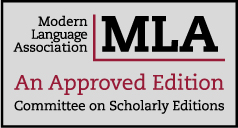Editorial Procedure
Different approaches will be taken in each part of the Aelfric Project. A Word for All Seasons will be more traditional, providing singular versions of texts surviving in unique copies or with limited manuscript variants. It will offer semi-diplomatic editions using modern punctuation, silently-expanded abbreviations, and standardized word-division based on normal dictionary practice and precedent set by standard editions of Ælfrician material. The Digital Ælfric, on the other hand, is designed to help scholars grapple with more fluid texts by directly engaging manuscript evidence informed by scholarly annotations. To this end, it makes full use of the flexibility and encoding opportunities offered by the Text Encoding Initiative Guidelines for Text Encoding and Interchange (P5).1 Using the TEI Guidelines for manuscript transcription, team members have sought to identify every instance of textual change--spelling, capitalization, word-order, abbreviations, additions, deletions, and so on--letter by letter.2 They have also added notes regarding sources, described features such as special capitalization and manuscript damage, and reconstructed illegible or lost passages. Regrettably, an early decision meant that the (digitally-available) Dictionary of Old English transcript of the homilies--based on an earlier version of Clemoes--was used as a base text, rather than Clemoes' published edition itself; variations from the DOE thus appear in red. Nonetheless, manuscript witnesses may still be compared with Clemoes side-by-side, with each sentence or phrase keyed to Clemoes' pages and line numbers, and analogous passages (when clicked on) visually highlighted in yellow. For full details of the guidelines for XML encoding followed by this project, see The Ælfric Project: Rules for Encoding
- ↑TEI P5: Guidelines for Electronic Text Encoding and Interchange. Edited by C.M. Sperberg-McQueen and Lou Burnard. Revised and re-edited by Syd Bauman and Lou Burnard. Oxford, Providence, Charlottesville, Bergen: The TEI Consortium. January 2005: http://www.tei-c.org/P5/Guidelines/.
- ↑See TEI P5 Chapter 18, “Transcription of Primary Sources”: http://www.tei-c.org/P5/Guidelines/PH.html.
 Introduction
Introduction Image Library
Image Library